Tutorial: Getting started with Kombilo¶
This document give you a step-by-step tutorial to setting up Kombilo and to getting started with the program.
Getting started¶
First you need to install the program. For Windows, there is an installer which will set up everything for you. For other operating systems, or if there are problems, look at the pertaining instructions: Linux, Windows, Mac OS X.
When you start Kombilo, the main window will open, with a go board in the middle, some widgets which belong to the SGF editor on the left, and the game list on the right.
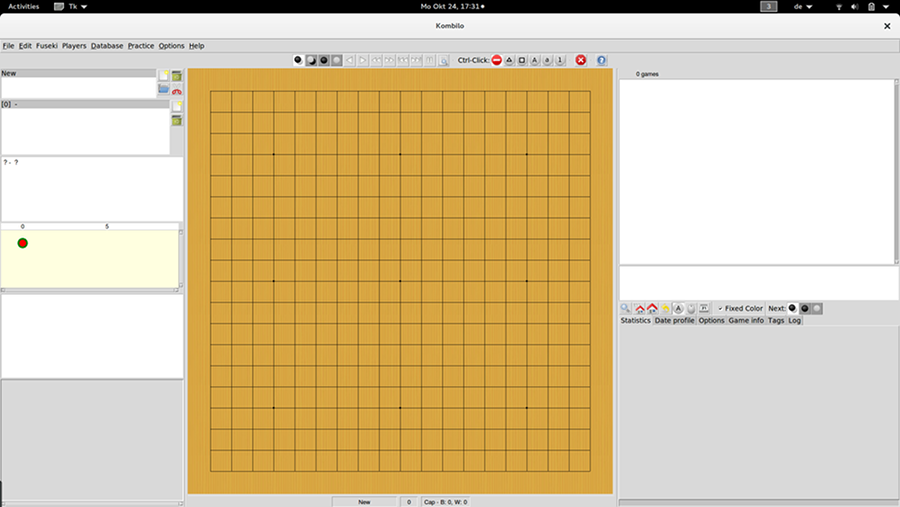
You can change the sizes of the columns by dragging the sashes (marked in red in the screenshot below) between them, and similarly for the horizontal panes in the left hand column.
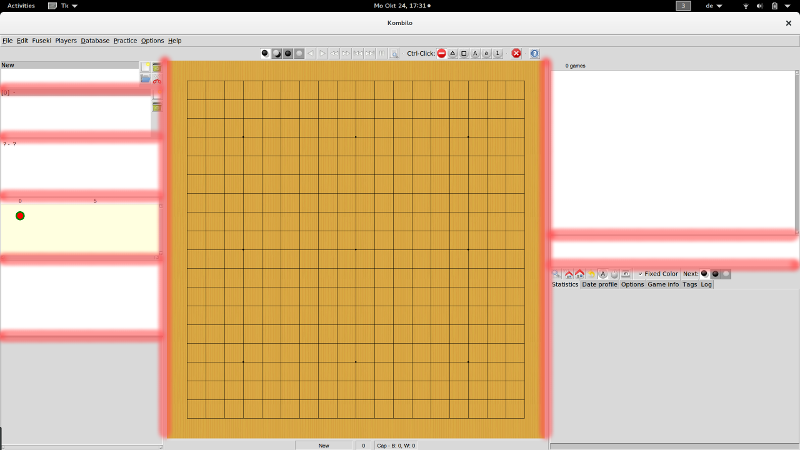
The first thing you have to do now is to add SGF files to the database list; choose the Edit DB list command in the Database menu.
A database is a collection of SGF files; the default is to create one database per folder of SGF files. Kombilo does not come with any games. You can either download a game collection (Where to find game records) from the internet, or buy a commercial one. The GoGoD encyclopedia comes with more than 85.000 at the time of writing, and is highly recommended. There are also several free collections around.
See also the section about Requirements on SGF files in order to understand which kind of SGF files the program can handle.
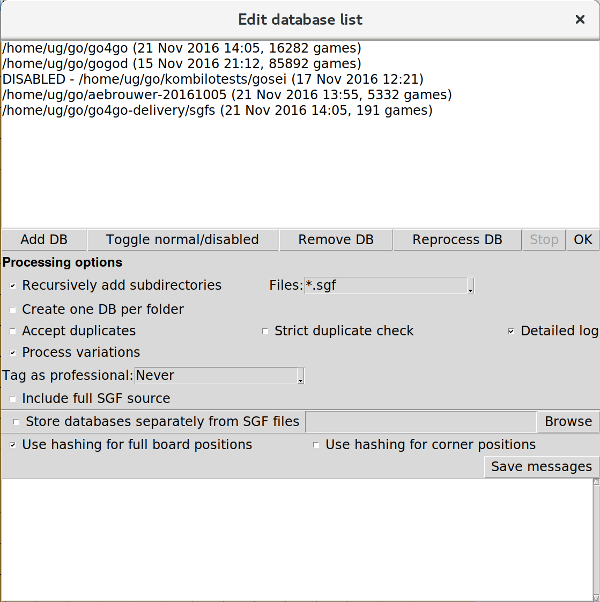
Check (and change, if necessary) the options - mainly whether all
subdirectories should also be added, and then use the Add DB button to
select a directory of SGF files. You can add several directories one after
the other. From a performance point of view, it is best not to have too
many databases, but rather to group your SGF files into few databases. Having
a database of 50,000 games should not be a problem. For much larger databases,
you need sufficient memory on your machine. Processing a database of 100,000
might require up to 1.5 gigabytes of RAM for Kombilo. If you uncheck the hash
algorithms, the memory usage during processing (and search performance ...) go
down considerably.
When you add a directory for the first time, the SGF files will be ‘translated’ into a format that makes the search more efficient. This processing takes quite some time; if you have thousands of games, it will take a couple of minutes even on a very fast machine. But this has only to be done once. The data will be written to several .db files in the same directory.
The sgf files remain in the directory, and Kombilo will not change them (unless you change the game info or edit the games yourself, of course). After the processing, the pattern search function actually does not use them anymore, but they are needed if you want to play through games with the SGF viewer.
If you chose to add all subfolders of the given folder recursively and note that processing takes too long, you can use the Stop button to interrupt it. This will not stop immediately, but will finish the currently processed folder (but not any subfolders) and write the database. The resulting database of course will not have all the SGF files, but other than that is fully functional. If you want to discard it, you can of course just delete it.
After having added one or more databases, close the Edit DB list window
using the OK button.
Warning
Character encodings
Currently, this version of Kombilo works well only with UTF-8 encoded files. Most SGF files produced in the western world are pure ASCII (which is a subset of UTF-8, and in particular can be handled by Kombilo), but many SGF files with asian characters are encoded using different character encodings and hence cannot be fed into Kombilo right away. This issue is not totally easy to resolve since the encoding is often not specified in the files. See Encodings.
Warning
Collections in very many folders
If you have a collection in very many (like hundreds or more) of folders with relatively few games each, you should switch off the Create one DB per folder option.
See Setting up the SGF databases for further details.
Searching for patterns¶
Now the game list should contain some files, and you can start the first search. Place stones on the board by clicking. Ctrl-click to remove stones, and Shift-click to place wildcards.
With the right mouse key (click and drag) you can select the search-relevant region; the rest of the board will be grayed out.
Everything outside that region is ignored: on the one hand it does not matter if there are additional stones on the main board, on the other hand all games will be found which feature the given pattern in the relevant region, no matter what else is on the board. Of course, mirroring and rotating the board is automatically taken into account.

Switch between placing black and white stones alternatingly, or stones of one color only by using the leftmost buttons in the toolbar on top.
When no region is selected, the whole board is relevant.
After defining the pattern and the relevant region, just click the search
button (the looking glass in the row of buttons directly below the game
list), or press Control-p (p attern search). In order to go back to the
complete game list, use the “reset game list” button - the leftmost button below
the game list, or press Control-r.
If you click on a game in the game list, the game info (players, result, komi, event, date etc.) is displayed below the game list.

By double-clicking on a game in the game list, you load the game to the SGF editor and you can look at that game. You can also start the viewer by selecting a game (by a single click) and pressing enter. If you prefer to open the game in a new window, use Shift-Click instead of double-clicking; cf. the corresponding option.
If you prefer, you can use your customary SGF editor instead of the SGF viewer coming with Kombilo; use the ‘Alternative SGF viewer’ command in the Options menu.
By clicking on a game with the right mouse key, a window will pop up where the complete game info is displayed, and can be edited. Note: By pressing OK in this window, the game info is written to the original SGF file.
In the Statistics tab in the lower portion of the right hand column,
some statistics will be shown about the continuations in the given
position.
In the first line you find the number of hits (which, obviously, can be bigger than the number of games in the list); after this number, in parentheses, is the number of matches with colors as on the board respectively reversed colors. Finally, you get the B/W winning percentages corresponding to the hits (i.e. a game where the pattern occurs several times, is counted that often).
Below some information on the continuations in the search position is given. For the ten most frequent continuations, you get
- the number of hits in which this continuation is played
- graphically, it is shown, how often white played at this point after a tenuki (light gray), how often white played there directly after the pattern was finished (white), how often black played there directly after the pattern was finished (black), and finally how often black played after tenuki at the given point.
- finally, below the letter labelling the corresponding point on the board (use the button with the labeled white stone to display the labels on the board), you get the black winning percentage for white playing at this point, and then the black winning percentage for black playing there. (Because there is not enough space, the winning percentage for white is not given, but of course (neglecting jigos etc.) it will be 100% - black winning percentage.

The labels are ordered by the number of occurrences of the corresponding continuation. (Unless there were already labels present in the search pattern: in that case Kombilo will use those labels to refer to the same intersections, and thus will not sort by frequency.) The sort criterion can be changed in the Options tab.
The color of the label indicates whether black or white (or both, depending on the game, in case of the gray labels) played on this point. If you have a sufficient number of games in your databases, this lets you create fuseki and joseki dictionaries very easily: See SGF tree search.
Clicking the calendar sheet button on the right of the toolbar below the game list switches the statistics view to a time line view, showing in which time period the different continuations were played.
After a search, you can clear the board with the start button above the
board. You can reset the game list (such that it contains all the games
again) with the reset game list button in the toolbar below the game
list, or by pressing Control-r. You can do both simultaneously using the
reset board and gamelist button right next to the looking glass below the game
list. In the file menu, you can also choose to do a “complete reset” - that will
reset Kombilo to the state right after it started up.
Pattern search options¶
There are several buttons to customize the search in the game list window:
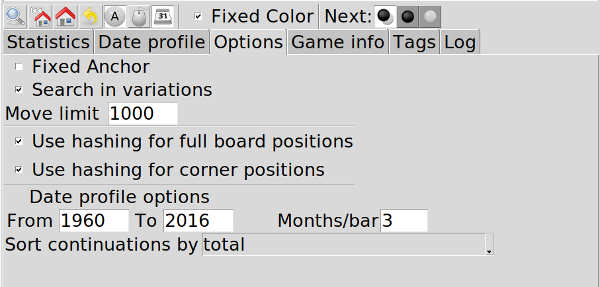
Usually the pattern obtained by reversing the colors is searched for too, but you can disable that with the ‘fixed color’ option.
As a default, Kombilo uses the ‘smart fixed color’ option, which automatically enables ‘fixed color’ for whole board searches, and disables it for all other searches. You can change that in the Options in the Options menu.
Furthermore, for a pattern on the edge or in the middle of the board, the program also looks for translations (in the mathematical sense, i.e., for occurrences of the same pattern at another place along the edge or on the board); this can be disabled by the fixed anchor option.
With the black/white, black and white buttons in the line below you can limit the search to patterns where black plays next or white plays next. This is sometimes useful, in particular for joseki searches with very few stones on the board. The default is to allow either a black or a white continuation (or no continuation at all).
Finally, you can impose a move limit, such that only games are found where the pattern occurs before the given limit.
You can also add wildcards to the search pattern, by shift-clicking on some point. These will be marked by small green circles, and mean that in the search these points may be either empty or contain a stone of either color.
For example, the following pattern finds all kos (that are not on the edge):
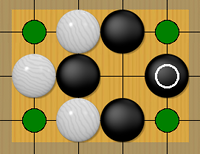
Shift-clicking again, the green circle will turn black (and, on the next shift-click, white), meaning that positions are found where this position is either empty or has a black stone (or, is empty or white, respectively).
Game Info search¶
If you are looking for games by a particular player, from a particular event or from a certain time period, you can use the game info search.
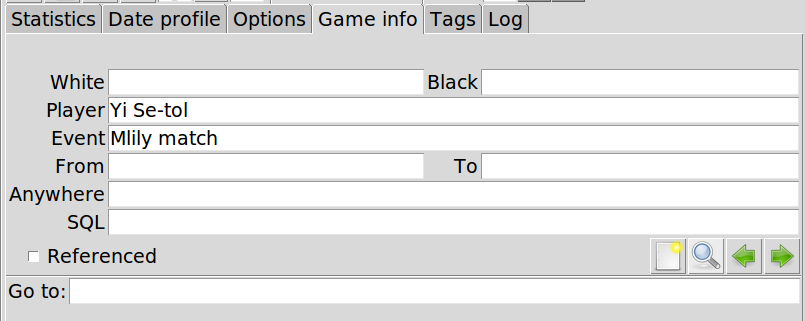
The games have to match all the requirements (Black Player, Event, ...)
simultaneously. The corresponding string has to occur at the beginning of
the data, but you can use the percent sign % as a wildcard, i.e. if you
enter ‘% Chikun’ as player, games where Cho Chikun played will be found.
The ‘Anywhere’ entry is simply a text search in the SGF file. This allows you to search for the result (use ‘RE[W’ or ‘RE[B’), for games which have a game comment (use ‘GC[‘), etc.
The SGF editor¶
You place stones by clicking (with the left mouse key) on an intersection. The four left-most buttons above the board control if you play black/white (resp. white/black) stones alternatingly, or if you place black (resp. white) stones, in order to set up a position.
In order to delete stones or to place labels, you have to select the appropriate tool among the ‘edit tools’ in the data window. Then you can perform the corresponding operation by holding down the Control key and clicking on an intersection.
With Shift + right-click you can go to the node where some move was/will be played.
Kombilo’s main board has two more features which are related to the pattern search: You can place wildcards on the board (resp. delete them) by shift+click, and you can select the relevant area for the pattern search by clicking the right mouse key, and dragging.

The navigation keys above the board let you move around in the current game record: one move back, one move forward, 10 moves back, 10 moves forward, to the beginning resp. to the end of the current game. All these can also be done by using keys: left, right, up, down, home, end.
If the current SGF file contains variations, you can switch between the alternatives for the current move with the PageUp and PageDown keys.
You can also use the SGF editor without the database functionality by opening games from the game list in the external viewer by Shift-click.
The SGF data column¶
In the left column of the window, you find all kinds of information about the currently opened SGF files.
File list¶

At the top of the right hand column, there is a list of all SGF files that have been loaded during the current session. The currently active file is highlighted; you can change that by clicking on another item in the list. The buttons on the right let you create a new file, open a file from disk, delete a file, or split a collection. Deleting a file just means deleting it from this file list. The file on your disk will not be deleted. Splitting a collection serves to split an SGF file which contains several games into many files with one game each. You will be asked for a filename, and the files will then be saved under the names filename0.sgf, filename1.sgf, filename2.sgf, etc.
If changes have been made to a file after it has been saved, the file name is preceded by a *.
Warning
By default, Kombilo will not ask you if you want to save the changes, so you have to pay attention to the *, and save the files yourself, if you want to keep the changes! You can change this behavior by selecting the corresponding option.
Game list¶
Below the file list there is a list of game records in the current SGF file. (Usually SGF files contain just a single game, so chances are that you will never use this pane. You can just minimize it to height 0.) You can select games by clicking on them, and change the order by drag and drop. The buttons on the right let you create new games and delete games from the list.
Game info¶
This shows part of the game information (names of players, result, date, etc.) of the current game. In order to see the full game information, or to edit it, use the button depicting a small looking glass over a sheet of paper above the go board.
Game tree¶
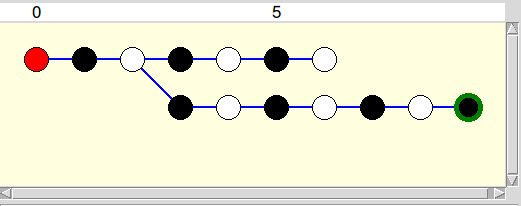
Here the tree structure of the current game is shown. Nodes with a black/white move are shown black resp. white; others are red. Nodes with a comment or a label on the board have a small blue dot in the center.
The green mark shows the current move (i.e. it corresponds to the position currently shown on the main board).
By clicking on a node, you can go to the corresponding move.
Comments¶
In this window the comments which the SGF file contains for the current node are displayed.
The game list column¶
The right column of the Kombilo window is the game list column.
At the top, the game list window shows the number of games currently in the list, and the B/W winning percentages (the two numbers will often not add up to 100% since there might be Jigo’s, unfinished games etc.)
Right below the list, there is a frame where (part of) the game information for the currently selected game in the list is shown (just click on a game to select it).
At the bottom, there is a “notebook” with one sheet (“tab”) each for the pattern search statistics, the date profile, the pattern search options, the game info search, tags and for messages.
Right above the notebook, there is a toolbar with several buttons and switches.

The ‘search’ button starts a pattern search. The ‘home/start’ button resets the game list and clears the board. The ‘home’ button resets the game list, so that it includes all the games in the database again. The ‘back’ button jumps back to the previous search: the position on the board is restored as well as the game list. (Previous search patterns are also shown on small boards in the “History” frame of the data window.)
With the button depicting a labeled white stone, you can display the labels showing the continuations in the current search pattern (resp. remove them again).
The button depicting a mouse toggles the 1-click mode. If this mode is active, every click on the board triggers a search. That can be quite practical in order to play through joseki sequences, say. If this mode is inactive, single clicks will just place a stone on the board. In this case, you can place a stone and start a search at the same time by double-clicking.
Check the fixed color checkbox to disable searching for patterns where black/white are exchanged. Use the Next option to specify that either player or black or white should move next in the selected area.
In the game info search window, you see entry fields for the search criteria: white/black player, player, event, etc. If you select the ‘Referenced’ option, only games with a reference to a commentary will be shown. The “clear” button clears all entries; the back and forward buttons restore the entries from previous searches. Unlike the back button for pattern searches, they do not change the game list. Last but not least, there is the button to start a search; you can also start the search by pressing Enter in one of the entry fields.
The Go to: field makes it easy to find specific games in the game list quickly. The ‘Go to’ entry always works with respect to the current sort criterion. Let’s assume that you sorted the database by date. Then entering something in the ‘Go to’ field will jump to the closest game in the game list the date of which starts with what you entered.
Date profile of the database¶
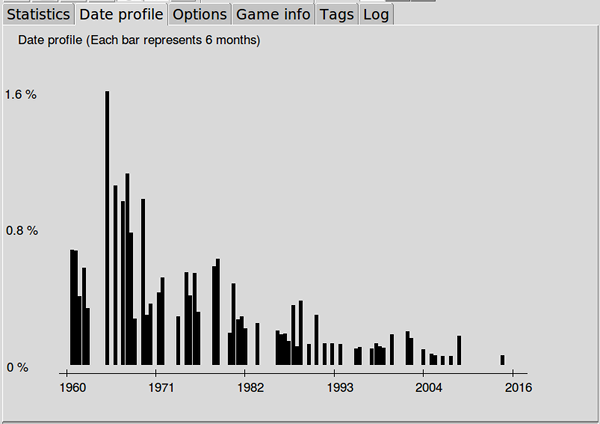
The Date profile tab shows you how the games which are currently in the game list are distributed over time. The height of each bar shows the proportion of games in the current game list with respect to all games in the database in the same time period. Say you do a pattern search, and then select the date profile tab. If one bar is twice as high as another one, then this means that in the first time period the pattern was played twice as much as in the second one. The height of the bars does not contain information about the absolute number of games in the current game list.
The time period shown can be changed in the Options tab.
You can also get date profile information on the different continuations in a pattern search: Open the statistics tab and enable the date profile view by clicking the calendar icon (the right-most icon in the icon set right above the statistics notepad):
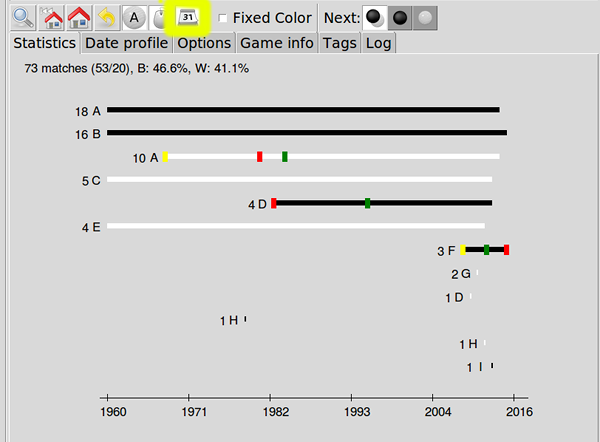
Tags¶
You can tag games in order to find them more easily and to carry through more complicated searches.

The Tags tab lists all existing tags. The following ones are built into Kombilo and are set (semi-)automatically:
- Handicap game; set automatically for all handicap games.
- Professional (a game where at least one professional player plays). You can choose during processing whether and in which way Kombilo should set this tag.
- Reference to commentary available; set automatically for all games for
which a reference to a game comment in the literature is available (and known
to Kombilo). You can configure which books/journals should be considered here
by editing the file
kombilo.cfgaccordingly. - Seen: set automatically for all games which you opened in the SGF viewer.
If you select a game in the game list, the tags which it carries are highlighted in the tag list. On the other hand, you can specify how tagged games should be marked in the game list (text color/background color).
Tag search¶
The tags in the tag list have an abbreviation which is written in square
brackets on the left hand side of the entry. You can search for tags using
these abbreviations, and combining them using the logical operators
and, or, not, and parentheses. So for example:
- H searches for all handicap games.
- S and C searches for all games you have previously opened, and for which a reference to a commentary is available.
- A and B and not C searches for all games which carry the tags A and B, but not the tag C (assuming that you created these tags before; see below).
Just enter the search expression into the entry field below the tag list and press enter, or click the looking glass button right of this field.
Creating new tags/deleting tags¶
To create a new tag, add its abbreviation (which must not yet be taken) followed by a space and the description of the tag, like this:
N My new tag
and click the button showing a plus sign.
To delete a tag from the tag list (and hence to remove it from all games), enter its abbreviation and click the button showing a minus sign.
Setting/removing tags on games¶

To specify the tags of a single game, select the game in the game list. The tags which it currently carries are highlighted. You can now select/deselect tags in the tag list by clicking them (use Control-click to select multiple entries). To set the chosen combination of tags on the selected games, click the second button from the left in the tags toolbar.
To add a tag to all games currently in game list, enter its abbreviation into the text entry field, and click the third button from the left. To remove a tag from all games currently in the game list, enter its abbreviation into the text entry field and click the fourth button from the left (depicting a broom).
For instance, you could create a tag A Large Avalanche Joseki, do a
pattern search for the large avalanche joseki, and tag all games in the
resulting game list with the tag A. Then you can easily search for all
these games, also in combination with other tags, and you can search for
all games where the large avalanche does not occur, by searching for not
A - and again, this can be combined with searching for other tags.
Search history¶
Selecting the Edit Advanced Options menu entry you can choose whether to display the search history at the bottom of the left hand column (the default) or as a tab on the right.
Click on one of the small boards to go back to the corresponding pattern search (i.e. the pattern and the game list are restored to what they have been right after the search).
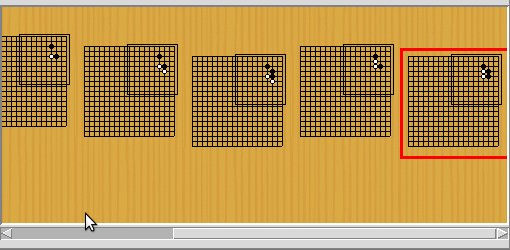
See also the Search History in the manual.
Analyzing a game¶
If you want to analyze a game of your own, just load it into the main board with the ‘Open’ command in the file menu (or use the ‘Open’ button next to the file list in the data window). Use the navigation buttons to navigate through the file, and search for patterns appearing in your game: for the first few moves you may want to do a whole board search, in order to see up to which point the fuseki you played also occurs in professional games, and afterwards you have to select an appropriate relevant region.
You can also load a fuseki or joseki dictionary. For example, Kombilo works quite well with Kogo’s joseki dictionary. To navigate all the variations, you should enable the ‘Show next move’ option. You may want to edit the file and change the date (SGF DT property) to a fake date in the future before adding it as a database, so that it will always be shown on top of the game list.
Guess next move mode¶
One fun way to study go is to replay professional games by guessing the next move. If you click on the corresponding button in the SGF edit toolbar in the data window, you enter Kombilo’s guess mode. That means that clicks on the board will be interpreted as guesses - if it coincides with the next move in the current SGF file, that move is played; otherwise no stone is placed on the board.
When you switch to the ‘guess next move’ mode, a small frame appears next to the game tree, which gives you some feedback on your guesses. If your guess is right, it displays a green square (and the move is played on the board).
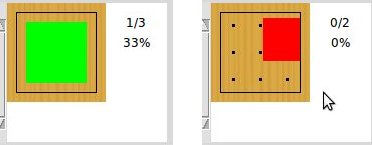
If the guess is wrong, it displays a red rectangle; the rectangle is roughly centered at the position of the next move, and the closer your guess was, the smaller is that rectangle. Furthermore the number of correct guesses and the number of all guesses, as well as the success percentage are given.
Of course, if you just can’t find the next move, you can always use the ‘Next move’ button above the board.
Further notes¶
Using Kombilo with non-latin (Unicode) characters¶
Kombilo works out of the box with UTF-8 encoded SGF files, but currently not with other encodings. To add non-UTF-8 files, you would have to find out their encoding and then recode them.
How can I reset the correct/wrong counter in the “guess next move” mode?¶
You can reset the counter by quitting and reentering the “guess next move” mode.
